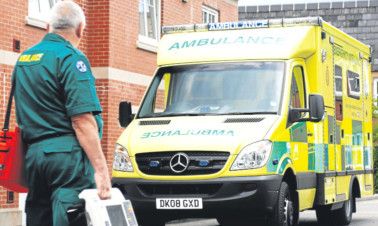
Ambulance staff in Scotland take more sick days than workers at any other NHS department in the country.
A Sunday Post probe has revealed the under-fire service has the highest absence rate of the 22 NHS organisations north of the border.
And across the UK’s 500 health boards, it comes fifth with a sickness rate of 6.5%.
Based on staff working 37.5 hours a week for 46 weeks a year, the average number of days off sick was 15 per employee in the 4,000-strong workforce.
That’s treble the average number of days off in the private sector. Unions have blamed the mammoth rate on “poor management and stress”.
The high sickness rate means 260 workers could be off at once.
Mick Conroy, senior organiser of the GMB union, claimed the sky-high absenteeism was driven by high stress levels and poor management.
He said: “It’s no surprise there’s been an increase in absenteeism within the SAS.
“This is due to bad management and the way in which front line staff are treated.
“They are stressed, morale is at rock-bottom and they are getting no support. There are ongoing issues within the management of the SAS.”
Long-term sickness costs the NHS £1.7bn a year but Mr Conroy claimed the bill could be brought under control.
He added: “We need the SAS to listen, not dictate to staff.”
In June The Sunday Post spoke to paramedic Maureen Gordon after her “deranged” paramedic husband was jailed following a two-year campaign of terror.
Grant Gordon, the father of three of Maureen’s four children, was found guilty of six sickening charges including chasing her with an axe and threatening to cut her throat.
Union bosses hit out at SAS management, claiming Maureen had contacted Grant’s bosses about his behaviour at work on numerous occasions but nothing was done.
A spokesman for the SAS said: “Ambulance crews undertake a very physically demanding job, often in challenging situations.
“The Service employs a range of measures that are being rigorously applied to manage sickness absence, including fast-track physiotherapy and employee counselling services.
“The absence rate for the first quarter of this year has reduced to 5.3%. It is anticipated that the introduction of a new national occupational health and attendance system will also improve attendance levels.
“We work closely with staff though formal national partnership forums and the claims made by the GMB, which we refute, have not been raised at these meetings the most recent of which took place this week.”

Enjoy the convenience of having The Sunday Post delivered as a digital ePaper straight to your smartphone, tablet or computer.
Subscribe for only £5.49 a month and enjoy all the benefits of the printed paper as a digital replica.
Subscribe